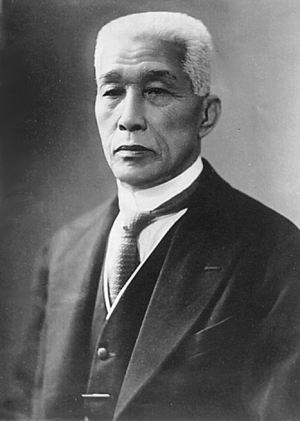
A slightly different version of this article appeared in Aikido Journal, 25:2 (1998). Copyright © 2000 Joseph R. Svinth. All rights reserved.
-- Yoshiaki (Yoshitsugu) Yamashita, circa 1887
In 1902, a wealthy Seattle businessman named Sam Hill was routinely working ten hours a day, six days a week. This prolonged absence caused his nine-year old son to turn "sickly," as being spoiled and selfish was then known. Rather than spend more time with the boy, Hill decided that judo, which he had seen demonstrated during a recent business trip to Japan, would be just the thing to imbue young James Nathan Hill "with the ideals of the Samurai class, for that class of men is a noble, high-minded class. They look beyond the modern commercial spirit."
Hill therefore asked I. Shibata, a Japanese friend living in New Haven, Connecticut, to find him a good judo teacher. In February 1903, Shibata told Hill of a Professor Yoshiaki (Yoshitsugu) Yamashita of Tokyo. [EN1]
Yamashita was born in Kanazawa City, in Ishikawa Prefecture, on February 16, 1865. The son of a minor samurai, he received some martial art training as a youth. In August 1884 he became the nineteenth member of Jigoro Kano’s Kodokan Dojo, where he began studying the jujutsu style that later became known as judo.

Yoshiaki Yamashita, early 1930s. Photo courtesy of the Joseph R. Svinth collection.
Despite all the stories about how it took years to get rank in the old days, Yamashita earned his 1-dan ranking after just three months at Kano’s school. Subsequent promotions continued apace, and he received his 4-dan after just two years. He was further promoted to 6-dan in 1898, and, upon his death in October 1935, he became the first person to receive posthumous promotion to 10-dan. Highly educated and urbane – he spoke good English and wrote beautiful Japanese – Yamashita quickly became a top-notch instructor. His postings included the Imperial Japanese Naval Academy and Tokyo Imperial University.
Yamashita’s skill was not solely theoretical, either. He was a member of the Kodokan teams that wrestled the Tokyo police jujutsu club in 1883 and 1884, and in 1946, the British judo pioneer E.J. Harrison, who studied judo at the Kodokan around 1905, told the following stories of Professor Yamashita’s practical fighting skills in the Budokwai Quarterly Bulletin:
Referring to the correspondence between Mr. I. Shibata and myself regarding your coming to America, I beg to state that I am now ready to carry out my proposition to you as made in February last.
My son will be next year in the city of Washington, D.C., from the first of October on. I have arranged so that if you will call at the office of the Nippon Yusen Kaisha [Japan Mail Lines] [EN3] in Tokyo they will furnish you transportation for yourself and your wife from Yokohama and Seattle, and I will pay for same. The steamship ‘Shinano Maru’ leaves Yokohama on the 22nd of September. If possible, I should like you to sail at that time. I shall, of course, furnish you with a railroad ticket from Seattle to Washington, D.C. for yourself and wife as well.
I am greatly interested in this matter and believe that you will do well, and I am very anxious that my boy should learn the art.
Trusting that you will be able to come to America and that I may hear from you at earliest moment to that effect.
In reply to your favor I am very glad to inform you that we are ready to start for America on the 22nd of September on board ‘Shinano Maru’ as you so kindly arranged for us.
I had been much bothered about how to show you the true art of our ‘jujutsu’ before accepting your proposition because I was afraid that there is no Japanese resident there who is able to show you the art as my opponent, but fortunately I have got a young Japanese gentleman, one of my pupils who is very clever and whose father is a judge of the Tokyo Supreme Court, who voluntarily applied to go to America with us at his own expense which I have gladly consented to.
Asking you to give our kindest regards to Mrs. Samuel Hill and your son.
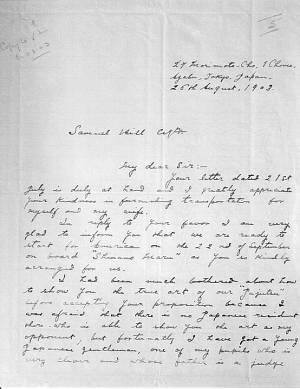
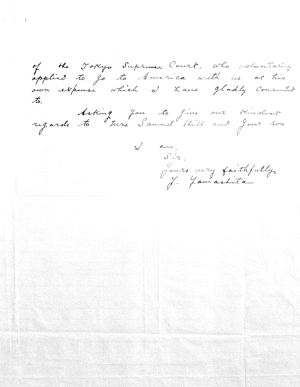
Letters reprinted courtesy of Maryhill Museum of Art. Images copyright Maryhill Museum of Art, http://www.maryhillmuseum.org/about.htm.
So, on September 23, 1903 the 38-year old Yamashita, his 25-year old wife Fude, and his 19-year old assistant Saburo Kawaguchi boarded the SS Shinano Maru in Yokohama. Since Hill was paying his fare, Yamashita traveled first-class. On the other hand, Kawaguchi traveled second-class, doubtless because his father was paying his way. Still, neither man traveled steerage. So when they arrived in Seattle fifteen days later Yamashita proudly told immigrations officials that he was a professor hired to teach "jujitsu" to Mr. Hill’s children. Kawaguchi just as proudly proclaimed himself Professor Yamashita’s assistant.
On Saturday, October 17, 1903 Yamashita and Kawaguchi gave a judo exhibition at the Seattle Theatre. This was a private show, not a public one; the theater was between shows, and Hill hired it for the evening. Guests included Sam Hill’s mother-in-law Mary Hill (wife of railroader J.J. Hill, the man of whom it was said, "In the West there are many mountains, but only one Hill,"), Senator Russell Alger (a Republican from Michigan, and a former Secretary of War), and several Seattle sports writers. So far as I know, this was the first time Kodokan judo was shown to a non-Japanese audience in North America. (Since journalist H. Irving Hancock had begun studying jujutsu in New York City as early as 1896, this statement refers solely to Kodokan judo.)
During his show, Yamashita told the audience that judo was a word meaning "victory by pliancy or yielding." What this meant, he was quoted in the Post-Intelligencer as saying, was that:
For Yamashita, the trip east was hardly wasted. For one thing, he got to see a lot of railroads along the way, which after all may have been one reason for the trip in the first place. (Yamashita’s sponsors included several leading Japanese industrialists.) For another, he had no trouble finding a job teaching judo to the children of the Washington elite. While his regular students were mostly rich men’s daughters -- Irving Hancock’s Physical Training for Women by Japanese Methods (1904) was then quite fashionable -- he didn’t mind, as according to an article in the New York World, Yamashita’s only requirement in his judo classes was "an absolute good temper." His wife was equally fortunate, and her students included the daughters of the Democratic vice-presidential candidate and a former governor of Mississippi. [EN4]
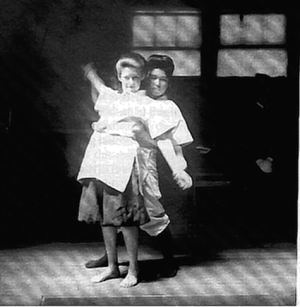
This photo from the Isamu Takeshita collection was probably taken in Washington, DC circa 1905; the woman on the right is likely Fude Yamashita. Photograph reproduced courtesy of Stanley Pranin and Aikido Journal.
While in the District of Columbia, Professor Yamashita gave some lessons at the Japanese Legation. The Japanese naval attaché, Lieutenant Commander Isamu Takeshita, was from a samurai family and knew a good thing when he saw it – in 1926, he persuaded aikido founder Morihei Ueshiba to move to Tokyo, and in 1935 he introduced aiki budo, as aikido was then known, into the United States. [EN5] So it is hardly surprising that in March 1904, he also arranged for Professor Yamashita to meet with President Theodore Roosevelt in the White House.
As Roosevelt put it in a letter to his sons, he believed in "rough, manly sports" so long as they did not "degenerate into the sole end of one’s existence… character counts for a great deal more than either intellect or body in winning success in life." And he thought he knew all about jujutsu. After all, in 1902, his wrestling instructor, a Philadelphia policeman named James J. O’Brien, had shown him some tricks he had learned in Japan. (O’Brien had been a constable at Nagasaki's Umegasaki Station from 1895 to 1899, so the instruction was legitimate.)
According to an article published in Literary Digest in August 1927, O’Brien began his demonstration by showing Roosevelt some technical illustrations. Suddenly Roosevelt stopped at a photo of a woman sticking her stiffened fingers into a man’s eyes.
‘Mr. President, a dangerous situation requires a desperate defense. That was invented to give a woman protection against a thug who suddenly attacked her.’
Colonel Roosevelt’s response, according to a writer in the Philadelphia Public Ledger, was reassuring.
‘I think, Captain,’ he is reported to have said, ‘that this is the best thing in your repertory.’
Although The World reported that there were seven degrees in jiu-jitsu, and Roosevelt intended to have at least five of them, Roosevelt’s primary goal in all this was not rank, but weight reduction. Since becoming President, his weight had soared to over 220 pounds, and he hoped to be down to 200 by the elections. So, during March and April 1904, Roosevelt practiced judo three afternoons a week, using a ground floor office in the White House as his workout space. Then, for the rest of the summer, he practiced occasionally. He stopped training during the elections, and there is no record showing that he resumed his studies afterward.
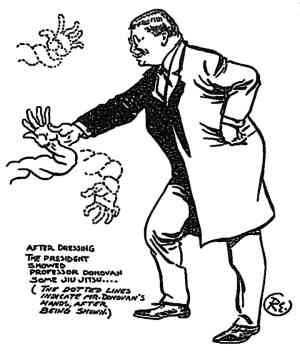
President Roosevelt practicing judo; illustration by Robert Edgren.
The President’s training partners included his sons, his private secretary, the Japanese naval attaché, Secretary of War William Howard Taft, and Secretary of the Interior Gifford Pinchot. When these people were unavailable, then Roosevelt tried his tricks on husky young visitors. The latter included Robert Johnstone Mooney, who with his brother visited the White House on the afternoon of Thursday, August 18, 1904. According to an article published in The Outlook in October 1923, Mooney’s brother was a noted amateur boxer. So, after doing a little sparring with the two young men, Roosevelt:
We replied in the negative, and he continued, pounding the air with his arms, ‘You must promise me to learn that without delay. You are so good in other athletics that you must add jiu-jitsu to your other accomplishments. Every American athlete ought to understand the Japanese system thoroughly. You know’ – and he smiled reminiscently – ‘I practically introduced it to the Americans. I had a young Japanese – now at Harvard [A. Kitagaki] – here for six months, and I tried jiu-jitsu with him day after day. But he always defeated me. It was not easy to learn. However, one day I got him – I got him – good and plenty! I threw him clear over my head on his belly, and I had it. I had it.’
The president probably agreed with these statements. For example, on March 5, 1904 he wrote his son Kermit:
Yamashita started at the Naval Academy in January 1905. Training took place Monday, Wednesday, and Friday afternoons. He earned $1,666 for the semester, but had to pay his own assistants. The class had about 25 students.
While teaching these classes Yamashita constantly stressed that what he taught was a gentlemanly art rather than something done by ruffians or professional wrestlers. Opinions regarding the quality of his instruction varied widely. According to the Army and Navy Journal for February 18, 1905 some believed "it was the best possible means of physical training, while others regard it of little value, indeed, of positive harm as inculcating unfair and unsportsmanlike ideas of physical contests."
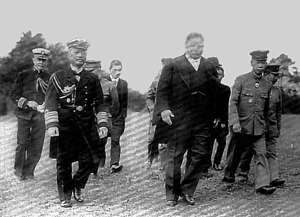
Theodore Roosevelt strolling with Lieutenant Commander Isamu Takeshita (left) during the negotiations that led to the Treaty of Portsmouth that led to the end of the Russo-Japanese War of 1904-1905. Photograph from the Isamu Takeshita collection, courtesy of Stanley Pranin and Aikido Journal.
Such debates occurred throughout North America during 1905. Much of the debate was engendered by the Russo-Japanese War, in which Japanese propagandists routinely attributed their successes to military judo training. And Irving Hancock and Robert Edgren, a pair of journalists who were touting the wrestling skills of a jujutsu man named Katsukuma Higashi, engendered more. [EN6] While the latter grossly exaggerated Higashi’s actual ability – he lost in three straight falls to an American wrestler named George Bothner in April 1905, and in minutes to a British judoka named Yukio Tani in November 1905 – the hype generated much controversy. Wanting to know the answer for himself, on Thursday, February 23, 1905 the President arranged a private match between Professor Yamashita and a middleweight catch-as-catch-can wrestler named Joseph Grant. In a letter to his son Kermit, Roosevelt described the outcome:

Tom Jenkins, US Military Academy wrestling instructor, 1906-1942. Photo courtesy of the United States Military Academy Archives. For details of Jenkins' professional wrestling career, see Mark Hewitt, "Tough as Barbed Wire," http://www.teal.org/wht/history/mh1.htm
Three weeks later Yamashita, Kitagaki, and Midshipmen McConnell, Piersol, Ghormley, and Heim gave their first public judo demonstration. [EN8] While the crowd watched politely, it greatly preferred the boxing and wrestling shows that followed. A second show given in May 1905 met an equally cool response. Said the Army and Navy Journal afterward:
Understandably upset, Yamashita complained to friends at the Japanese Legation that he had turned down several jobs during the summer, thinking that the Navy would be rehiring him in the fall. And, as this left him with insufficient funds for another year in America, he began making plans to return to Japan.
About the same time that Yamashita was packing his bags, President Roosevelt happened to ask the Japanese ambassador how his former judo teacher was doing. Upon hearing the answer, the President asked the Secretary of the Navy if there was some reason that Yamashita should not be rehired for at least one more year. As Secretary Charles J. Bonaparte could not think of a reason he cared to tell the President, he immediately sent a letter to the new Superintendent of the Naval Academy, Rear Admiral James H. Sands, asking him to "please take the necessary steps to comply with the wishes of the President." As one would expect, Admiral Sands in turn wasted no time telling his staff to find a way of funding the President’s judo program.
Within two weeks the Naval Academy staff had designed a curriculum and moved $1,700 into the appropriate budget. Admiral Sands then asked Yamashita to please come by his office in Annapolis "to arrange for the course of instruction in Judo." On December 4, 1905, Admiral Sands signed a contract with Yamashita in which the latter was to give fifty one-hour lessons at $33.33 per lesson. The class was taught during the first half of 1906. On May 6, 1906 Admiral Sands wrote the Navy Department to say that the course had been completed, but suggested that it not be repeated in 1907, as it was the opinion of both himself and his staff that "a knowledge of Jiu-jitsu is not of great value to those who are being prepared for a life on shipboard." President Roosevelt once again begged to differ, and so money was allocated for the purpose of bringing Yamashita back for a third year. But following the end of the 1906 academic year Yamashita left the United States for Japan, and on July 24 he attended an important judo conference held in Kyoto. His absence was hardly remarked by the US Navy, which did nothing more with judo until 1943. [EN9]
Meanwhile, back in Seattle, Sam Hill was annoyed. He had brought Yamashita to America to teach judo to his son, and then the Professor had deserted James Nathan for that damned cowboy in the White House. So, for the rest of his life, Hill would complain to anyone who would listen that Roosevelt had "taken away from Harvard my judo man without my permission or even asking."
And with that proclamation, Kodokan judo quit being of much interest to Seattle’s elite, and instead became something done almost entirely by the sons of Japanese immigrants.
ACKNOWLEDGMENTS
Financial support from the Japanese American National Museum and King County Landmarks and Heritage Commission contributed to the completion of this article.
The assistance of Richard Bowen, Alice S. Creighton (US Naval Academy,
Nimitz Library, Special Collections), Wallace Dailey (Harvard College Library,
Theodore Roosevelt Collection), Shinji Kozu, William J. Long, Judith Sibley
(US Military Academy Archives, Special Collections), Robert W. Smith, and
David Waterhouse is also gratefully acknowledged.
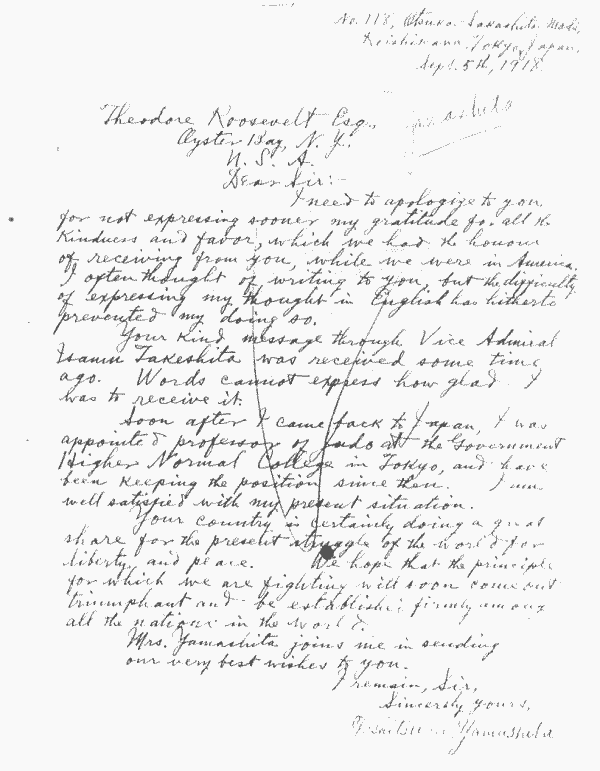
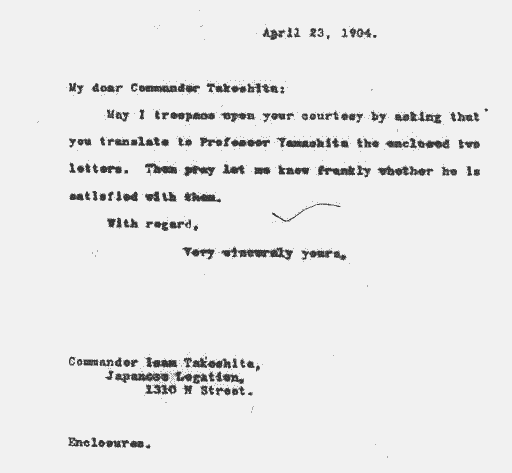
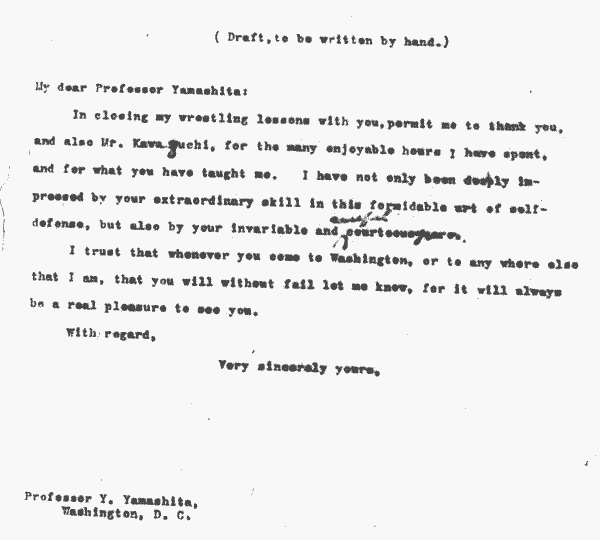
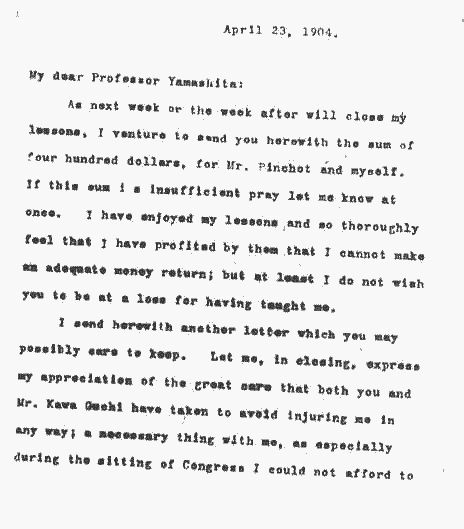
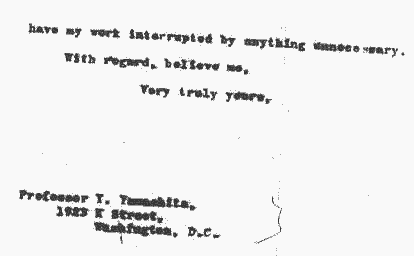
EN1. The ideogram used to write Yamashita’s first name could be transliterated as Yoshitsugu, Yoshiaki, or Yoshikazu. In Kodokan documents it is usually transliterated Yoshiaki, but his passport in 1903 read Yoshitsugu.
EN2. The assault was probably politically motivated. In Revue Judo Kodokan, II (September 1952), 125, Kainan Shimomura wrote, "Yokoyama and Yamashita, the pioneers of Judo, were appointed Professors to the State Police Force, following on a Gala of Budo (martial arts) during which different Schools of Jujutsu opposed one another, but the numerous Societies of the ancient Jujutsu, which continued to exist, despised the ‘Judo of Kodokan’ at the bottom of their hearts. Encounters between Professors of the State were the exception. However public opinion got so worked up that in January 1891 an inter-group combat took place…"
EN3. On August 31, 1896, the steamer SS Miike Maru became the first NYK ship to enter Puget Sound. The ship carried 186 tons of cargo and one steerage passenger to Seattle and on its return to Japan carried six first-class and 33 steerage passengers. Thus the arrival of the NYK initially reduced Seattle’s Japanese population by 9%! For further details, see http://seattletimes.nwsource.com/centennial/january/partners.html.
EN4. For details, see "Jiu-Jitsu for Women: Sandow's Magazine," http://ejmas.com/jalt/jaltframe.htm.
EN5. See Stanley Pranin's article at http://omlc.ogi.edu/aikido/talk/osensei/bio/mori4.html and Joseph Svinth, "Aikido Comes to America, September 1935," at Volume I of Journal of Combative Sport at http://ejmas.com/jcs/jcsframe.htm.
EN6. See, for example, "The Fearful Art of Jiu-Jitsu" by Robert Edgren at http://ejmas.com/jcs/jcsframe.htm.
EN7. In March 1918, Peyton C. March became Chief of Staff, US Army, a position he held until retirement in January 1921. Frank W. Coe became the Chief of Coast Artillery in May 1918, a position he held until retirement in March 1926. For a biographical sketch and portrait of General March, see http://www.army.mil/cmh-pg/books/cg&csa/March-PC.htm.
EN8. Between 1881 and 1906, sixteen Japanese attended the US Naval Academy. A. Kitagaki, however, failed to gain admission because in 1906 Congress passed laws that prohibited the Academy from accepting foreign students. Robert L. Ghormley of Moscow, Idaho played three years of varsity football at the Academy. He was supreme commander of Allied naval forces during the Guadalcanal campaign of 1943 and retired as a vice admiral in 1946. Philadelphia’s William Burton Piersol was injured while playing football at the Academy and resigned immediately following graduation. He then got a job designing propellers for various marine firms and served as a commander during World War II. Riley Franklin McConnell of Gate City, Virginia was the heaviest man in his class at the Academy. His sports included football, track, and what the school yearbook, the Lucky Bag, called "jui jitsu." He retired as a commander in 1924. Finally, Schuyler Franklin Heim of Plymouth, Indiana was the Academy lightweight wrestling champion. Lucky Bag 1907 said that Heim looked "like a Jap, and can beat all comers at the art of Judo, which he asserts is more refined than Jiu Jitsi [sic], because it is sure death." He retired as a commodore in 1946, and is commemorated by the Terminal Island Bridge in Long Island, California that carries his name.
EN9. The Department of the Navy’s subsequent interest in judo dates to February 1943, and a contest in which a 143-pound judoka choked a 200-pound professional wrestler unconscious in 1 minute, 20 seconds. For a description of that contest, see Joseph R. Svinth, "Judo Battles Wrestling: Masato Tamura and Karl Pojello," Furyu, The Budo Journal, 3:2 (Summer/Autumn 1999), 30-36, 72.